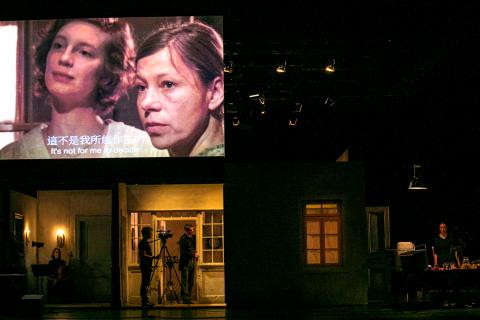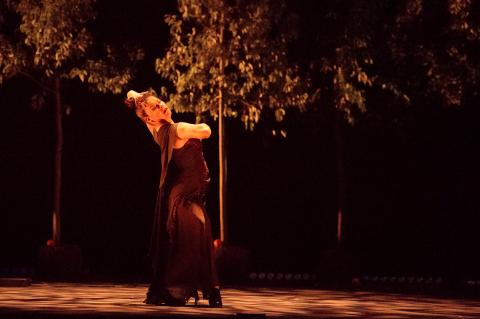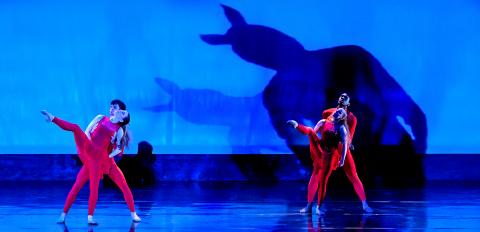For theater and film buffs, British director Katie Mitchell’s production of Miss Julie for Berlin’s Schaubuhne theater at the National Theater last weekend was a treat.
Mitchell’s retelling of Swedish author and playwright August Strindberg’s 1888 classic one-act play about class, gender and rebellion focuses on a behind-the-scenes view of Miss Julie, servant Jean and Kristen, the cook and Jean’s fiancee.
Not only does she tell the story through Kristen’s eyes and ears, the audience sees the action from behind doors and through windows as well, as live theater is combined with video footage, both live and prerecorded, helped by Leo Warner’s film direction.

Photo: Courtesy of Chou Chia-Hui / NTCH
The set is a mix of walls, windows and doors — with the walls moved back and forth to create small rooms, corridors, outdoor walkways — as well as two sound booths, props and shelving and a table where the sound foley crew of Maria Ueberschaer and Lisa Guth work their magic so that the audience can hear what Kristen and the other actors are doing.
In addition to Jule Bowe as Kristin, Tilman Strauss as Jean and Luise Wolfram as Miss Julie, the audience could watch Cathlen Gawlich as Kristen’s double, camera operators Andreas Hartmann and Krzysztof Honowski and cellist Gabriella Strumpel.
Everybody helps out. When not required for a scene, the actors help the film crew shift the walls, cameras and lighting equipment. It is a modern-day take on Strindberg’s stage directions that everything in a performance is done as naturally as possible.

Photo: Chang Chen-chou / NTCH
Mitchell does not tackle the entire play; she takes it as a given that the audience knows the basic story outline so she can focus on the small, everyday things, with the video providing an intimacy that usual stage productions cannot give.
In the videos, the audience sees Kristen washing and slicing a kidney for Jean’s meal and later serving it to him with extra helpings of gravy, or using a glass pressed to the floorboards to listen to a fight between Miss Julie and Jean in the room below — actions that would have otherwise been hidden by the set walls or too far away for most audience memebers to see.
The dialogue was minimal, with surtitles projected as part of the video, and the acting restrained.

Photo: courtesy of Bill Naimann
The overall effect of Mitchel’s vision was beautiful, and for those who are interested in the technical side of stage and movie productions, seeing it was a delight akin to being a child let loose in a sweet shop. However, like sweet shops, the visual stimulation in the end was overwhelming: There was just so much to look at that in the end you feared that you might have missed the best bits.
The visual delights of Miss Julie, brought to the National Theater as part of the Taiwan International Festival of Arts, were equaled the preceding weekend by another program in the festival’s line-up, the Rocia Molina Company’s Bosque Ardora.
Conceived by, directed by and starring Molina, the production promised something more than the usual flamenco show and it delivered.
The show opens with a beautiful short film of nature — beautifully colored dawn sky, verdant trees, a lake or river, insects and animals into which the baying sounds of hunting dogs and a galloping horse’s hoofs can gradually be heard.
Then glimpses of a horse and female rider; the hunted or the hunter? There is no way to tell before the rider, Molina, is unceremoniously dumped into the water by her horse, which gallops off.
The screen rises to the sounds of dripping water and the crouching figure of Molina is seen on tree-laden stage dressed as the rider, but with a fox’s head mask on her forehead.
Carlos Marquerie’s terrific lighting gives the scene a dreamlike quality as Molina shifts from animal-like crawls and stretches to more human moves, beginning her story that mixes Greek mythology with Spanish flair.
Molina is always captivating, whether portraying a fox, a goddess, a hunter or a seductress — or tottering on her heels in a “morning-after” sequence that drew comparisons with Charlie Chaplin’s physical comedy. One very short solo performed facing guitarist Eduardo Trassierra — who was terrific — was worth the price of admission alone.
Molina was more than even matched by Eduardo Guerrero and Fernando Jimenez, who really did not have that much to do until a great solo toward the end for Jimenez.
Kudos also to guitarist Eduardo Trassierra, Pablo Martin Jones on drums, Jose Vicente Ortega and Agustin Orozco on trombone and Maria Karolina Gonzalez Martinez for her “Palmas y Compas, ” but I was less impressed with singer Jose Javier Guerrero Hernandez.
The show ended as it began, with a hunter and fleeing prey, only unlike the opening video, the prey does not escape.
While Molina and crew were delighting audiences in the main theater, upstairs in the Experimental Theater, Body Expression Dance Theatre (BodyEDT, 體相舞蹈劇場) and the Cleveland, Ohio-based Verb Ballets were performing their Mix+Multi Arts Festival program, which turned out to be a mixed bag indeed.
The performance that I saw featured three works performed by the US dancers, Anthony Krutzkamp’s Appropriated Memories, Daniel Precup’s duet Ne me quitte pas and Body EDT director Lee Ming-cheng’s (李名正) The Arrival of Departure, followed by Lee’s latest work, Initial — space starting (空間起點) performed by his company.
Appropriated Memories was performed by all eight Verb Ballets dancers, paired into four couples. While not an especially memorable piece, it was pleasant, with lots of great lifts and a tender duet, performed at the show I saw by Christina Lindhout and Stephan Hood, who were great.
Kate Webb and Michael Hinton were terrific in Ne me quitte pas, a short and sweet piece inspired by and set to Jacques Brel’s song by the same name.
I was less taken with Lee’s two works, which relied on computer-generated projections for their visual impact, which was too bad since I am usually a fan of Lee’s, and too often the projections were more interesting than the dancers. Verb Ballets’ dancers gave The Arrival of Departure their best effort, but the piece, with a lot of Lee’s usual insect-like floorwork, did not play to their strengths.
However, at least the visuals and the dancing seemed to go together for Initial — space starting, giving the impression of travelers moving through vortexes, but the overall lighting for the work often left the dancers largely in the dark.

One of the biggest sore spots in Taiwan’s historical friendship with the US came in 1979 when US president Jimmy Carter broke off formal diplomatic relations with Taiwan’s Republic of China (ROC) government so that the US could establish relations with the People’s Republic of China (PRC). Taiwan’s derecognition came purely at China’s insistence, and the US took the deal. Retired American diplomat John Tkacik, who for almost decade surrounding that schism, from 1974 to 1982, worked in embassies in Taipei and Beijing and at the Taiwan Desk in Washington DC, recently argued in the Taipei Times that “President Carter’s derecognition

This year will go down in the history books. Taiwan faces enormous turmoil and uncertainty in the coming months. Which political parties are in a good position to handle big changes? All of the main parties are beset with challenges. Taking stock, this column examined the Taiwan People’s Party (TPP) (“Huang Kuo-chang’s choking the life out of the TPP,” May 28, page 12), the Democratic Progressive Party (DPP) (“Challenges amid choppy waters for the DPP,” June 14, page 12) and the Chinese Nationalist Party (KMT) (“KMT struggles to seize opportunities as ‘interesting times’ loom,” June 20, page 11). Times like these can

June 23 to June 29 After capturing the walled city of Hsinchu on June 22, 1895, the Japanese hoped to quickly push south and seize control of Taiwan’s entire west coast — but their advance was stalled for more than a month. Not only did local Hakka fighters continue to cause them headaches, resistance forces even attempted to retake the city three times. “We had planned to occupy Anping (Tainan) and Takao (Kaohsiung) as soon as possible, but ever since we took Hsinchu, nearby bandits proclaiming to be ‘righteous people’ (義民) have been destroying train tracks and electrical cables, and gathering in villages

Dr. Y. Tony Yang, Associate Dean of Health Policy and Population Science at George Washington University, argued last week in a piece for the Taipei Times about former president Ma Ying-jeou (馬英九) leading a student delegation to the People’s Republic of China (PRC) that, “The real question is not whether Ma’s visit helps or hurts Taiwan — it is why Taiwan lacks a sophisticated, multi-track approach to one of the most complex geopolitical relationships in the world” (“Ma’s Visit, DPP’s Blind Spot,” June 18, page 8). Yang contends that the Democratic Progressive Party (DPP) has a blind spot: “By treating any